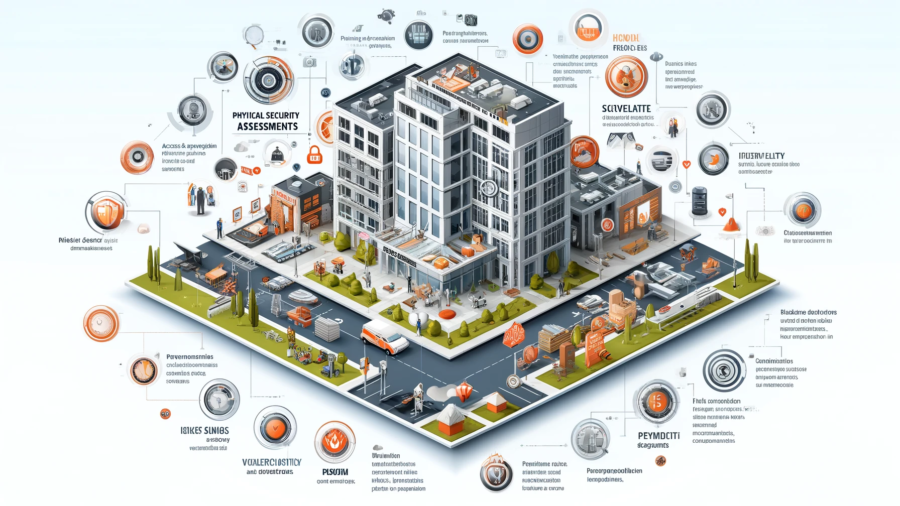Physical security assessments are critical in safeguarding buildings and property against potential threats. These assessments help identify vulnerabilities that could be exploited, ensuring that appropriate measures are in place to protect assets and personnel. This blog explores the importance of physical security assessments, the process involved, and how to address identified vulnerabilities.
The Importance of Physical Security Assessments
Physical security assessments are essential for several reasons. They provide a comprehensive evaluation of the security measures in place, identify weaknesses, and recommend improvements to enhance overall security.
Risk Mitigation:
- Physical security assessments help mitigate risks by identifying vulnerabilities that could lead to security breaches. This proactive approach ensures that potential threats are addressed before they can cause harm.
Compliance with Regulations:
- Many industries are required to comply with specific security standards and regulations. Conducting regular physical security assessments ensures that these requirements are met, avoiding potential fines and legal issues.
Protection of Assets and Personnel:
- By identifying and addressing vulnerabilities, physical security assessments protect valuable assets and ensure the safety of personnel. This is crucial for maintaining business operations and safeguarding employees.
The Process of Physical Security Assessments
Conducting a physical security assessment involves several steps. Each step is designed to thoroughly evaluate the security measures in place and identify areas that need improvement.
1. Planning and Preparation:
- The first step in a physical security assessment is planning and preparation. This involves defining the scope of the assessment, identifying key areas to evaluate, and gathering relevant information about the property.
2. On-Site Inspection:
- An on-site inspection is conducted to evaluate the physical security measures in place. This includes examining access control systems, surveillance equipment, perimeter security, and other physical barriers.
3. Vulnerability Identification:
- During the on-site inspection, vulnerabilities are identified. This could include weak points in the perimeter, malfunctioning security equipment, or gaps in access control measures.
4. Risk Analysis:
- Once vulnerabilities are identified, a risk analysis is conducted to determine the potential impact of each vulnerability. This helps prioritize the issues that need immediate attention.
5. Recommendations and Reporting:
- After the risk analysis, recommendations are provided to address the identified vulnerabilities. A detailed report is generated, outlining the findings and suggested improvements.
Identifying Vulnerabilities in Buildings
Buildings can have numerous vulnerabilities that compromise security. Identifying these weaknesses is a critical aspect of physical security assessments.
Access Control:
- Weaknesses: Unauthorized access can occur due to weak or outdated access control systems.
- Solutions: Implementing advanced access control measures, such as biometric systems and key card access, can enhance security.
Surveillance Systems:
- Weaknesses: Surveillance systems may have blind spots or outdated technology, reducing their effectiveness.
- Solutions: Upgrading to high-definition cameras and ensuring comprehensive coverage can improve surveillance capabilities.
Perimeter Security:
- Weaknesses: Gaps in fencing or inadequate lighting can make the perimeter vulnerable to intrusion.
- Solutions: Reinforcing fencing, installing motion-sensor lighting, and using security patrols can strengthen perimeter security.
Physical Barriers:
- Weaknesses: Insufficient physical barriers, such as poorly constructed walls or doors, can be easily breached.
- Solutions: Strengthening physical barriers with reinforced materials and adding security features like shatterproof glass can enhance protection.
Identifying Vulnerabilities in Property
Property vulnerabilities can also pose significant security risks. Addressing these issues is essential for comprehensive protection.
Parking Areas:
- Weaknesses: Poorly lit or unsecured parking areas can be hotspots for criminal activity.
- Solutions: Improving lighting, installing surveillance cameras, and implementing access control for parking areas can enhance security.
Landscaping:
- Weaknesses: Overgrown shrubs and trees can provide cover for intruders.
- Solutions: Regular landscaping maintenance and using low-height plants can reduce hiding spots and improve visibility.
Storage Areas:
- Weaknesses: Unsecured storage areas can be targeted for theft or vandalism.
- Solutions: Securing storage areas with robust locks, surveillance, and regular inspections can protect stored items.
Outdoor Equipment:
- Weaknesses: Unsecured outdoor equipment can be easily stolen or damaged.
- Solutions: Using secure storage solutions and surveillance can deter theft and vandalism of outdoor equipment.
Addressing Identified Vulnerabilities
Addressing the vulnerabilities identified during physical security assessments is crucial for enhancing overall security. Implementing the recommended improvements can significantly reduce the risk of security breaches.
| Vulnerability | Solution |
|---|---|
| Weak access control systems | Implement advanced biometric or key card access systems |
| Outdated surveillance systems | Upgrade to high-definition cameras with comprehensive coverage |
| Gaps in perimeter security | Reinforce fencing, install motion-sensor lighting, use security patrols |
| Insufficient physical barriers | Use reinforced materials, add security features like shatterproof glass |
| Poorly lit parking areas | Improve lighting, install surveillance cameras, implement access control for parking |
| Overgrown landscaping | Regular maintenance, use low-height plants for better visibility |
| Unsecured storage areas | Secure with robust locks, surveillance, and regular inspections |
| Unsecured outdoor equipment | Use secure storage solutions and surveillance |
The Future of Physical Security Assessments
The future of physical security assessments looks promising with advancements in technology. Innovations such as artificial intelligence (AI), machine learning, and Internet of Things (IoT) devices are revolutionizing the way assessments are conducted.
AI and Machine Learning:
- AI and machine learning can analyze vast amounts of data from surveillance systems to detect unusual activities and predict potential security breaches. This enhances the effectiveness of security assessments and allows for real-time response to threats.
IoT Devices:
- IoT devices, such as smart sensors and connected cameras, provide continuous monitoring and real-time data. This enables more accurate and comprehensive security assessments, ensuring that vulnerabilities are promptly identified and addressed.
Integrated Security Solutions:
- Integrated security solutions combine various security measures into a cohesive system. This holistic approach ensures that all aspects of physical security are covered, from access control to surveillance and perimeter security.
Physical security assessments are vital for identifying vulnerabilities in buildings and property. By thoroughly evaluating the existing security measures, identifying weaknesses, and implementing recommended improvements, organizations can significantly enhance their overall security. The future of physical security assessments is set to be even more effective with advancements in technology, ensuring comprehensive protection against potential threats. As we continue to prioritize security, these assessments will play a crucial role in safeguarding assets and ensuring the safety of personnel.
By conducting regular physical security assessments and addressing identified vulnerabilities, we can create a safer and more secure environment for everyone.
Read more Blogs. Written By Mobi.

